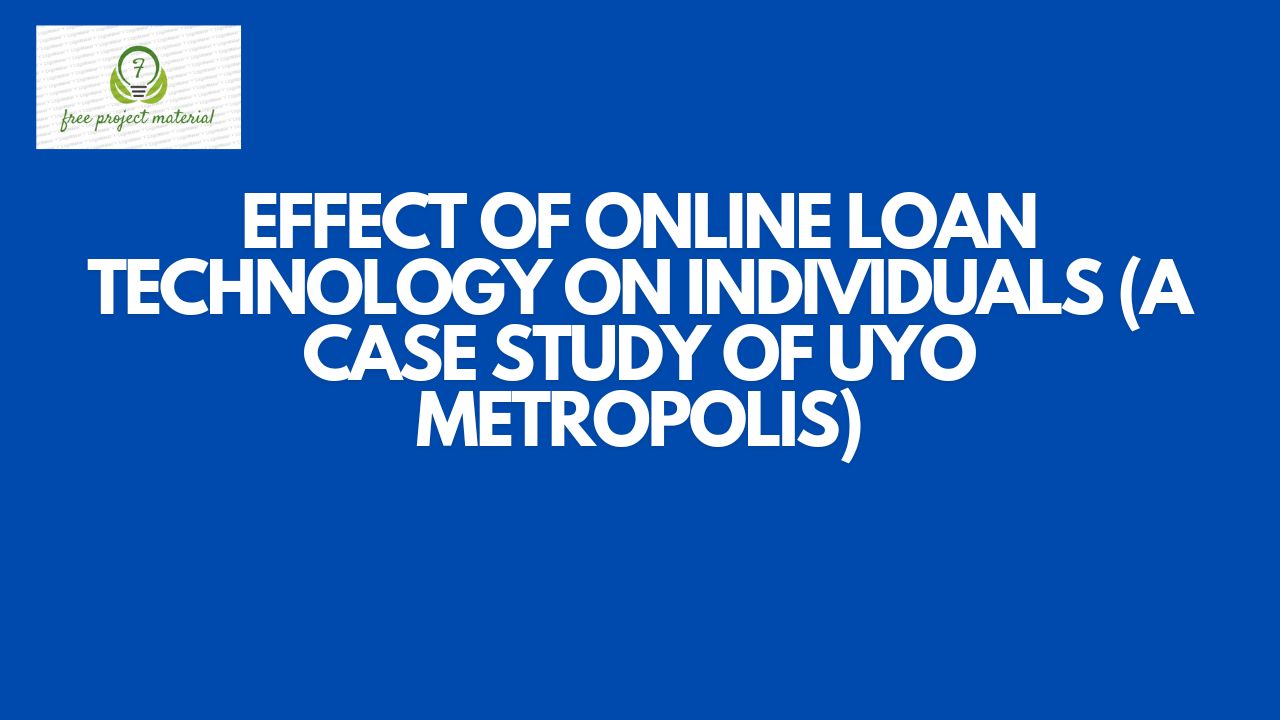ABSTRACT
The aim of this study was to examine the effect of online loan technology among the residents of Uyo metropolis. The main objective of this study is to evaluate the effect of online loan technology on individuals. The instrument use for this study were both primary and secondary sources. Questionnaire form was used for the collection of primary data. A descriptive and explanatory research design was used. A sample size of 400 was randomly selected at convenience from the total population size of 427,873 which is the population of Uyo metropolis. The sample were analyzed using simple statistical tools such as frequency table and percentages. The findings of this study revealed that: The level of usage of online loan among the residents of Uyo metropolis is high, in terms of effectiveness in service delivery, online loan technology is good. Furthermore, the problems associated with online loan technology includes: no negotiation in case of change of default plan, access is totally online as such no face to face contact, and there is high possibility of fraudulent action and the solutions to the problems of online loan technology includes; regulations by appropriate government authorities, registration of all online loan companies in Nigeria, collection of the necessary information from customers by the online loan companies. The researcher recommended that the relevant government and finance authority should make stringent regulations of the activities of the online loan companies operating in Nigeria.
LIST OF TABLES
Table 4.2.1: Responses from Research Question One – – 40
Table 4.2.2: Responses from Research Question Two – – 41
Table 4.2.3: Responses from Research Question Three – – 42
Table 4.2.4: Responses from Research Question Four – – 44
TABLE OF CONTENTS
Title page- – – – – – – – – – i
Certification- – – – – – – – – ii
Dedication – – – – – – – – – iii
Acknowledgements- – – – – – – – iv
Abstracts- – – – – – – – – – v
List of Tables – – – – – – – – vi
Table of contents- – – – – – – – – vii-ix
CHAPTER ONE
INTRODUCTION
1.1 Background of the Study – – – – – – 1-3
1.2 Statement of the Problem – – – – – – 3-4
1.3 Objectives of the Study- – – – – – – 4
1.4 Research Questions- – – – – – – 4-5
1.5 Significance of the Study – – – – – – 5
1.6 Scope and Limitation of the Study- – – – – 5-6
1.7 Organization of the Study- – – – – – 6-7
1.8 Definition of Terms- – – – – – – 7-9
CHAPTER TWO
REVIEW OF RELATED LITERATURE
2.1 Concept and Meaning of Loan- – – – – – 10-11
2.2 Types of Loan- – – – – – – – 11-14
2.3 Consequences of Loan Default On Individual- – – 14-16
2.4 Causes of Loan Default- – – – – – – 16-21
2.5 Effects of Loan Default- – – – – – – 21-22
2.6 Challenges Or Problems Associated With Online
Loan Technology- – – – – – – – 23-25
2.7 What NITDA is saying about debt collection strategy- – 25-26
2.8 Online Lenders’ Common Problems and How
To Solve Them- – – – – – – – 26-30
2.9 Advantages And Disadvantages Of Online Loan- – – 30-33
2.10 Solutions to the Challenges of Online Loan Technology- – 33-35
CHAPTER THREE
RESEARCH METHODOLOGY
3.1 Introduction – – – – – – – – 36
3.1.1 Research Questions- – – – – – – 36
3.2 Design of the Study- – – – – – – 36
3.3 Area of the Study- – – – – – – – 37
3.4 Population of the Study- – – – – – – 37
3.5 Sample and Sampling Techniques- – – – – 37-38
3.6 Instrument and Method of Data Collection- – – – 38
3.7 Data Analysis Techniques- – – – – – 39
CHAPTER FOUR
DATA PRESENTATION, ANALYSIS AND INTERPRETATION
4.1 Introduction- – – – – – – – 40
4.2 Data Presentation- – – – – – – – 40-46
CHAPTER FIVE
FINDINGS, CONCLUSION AND RECOMMENDATIONS
5.1 Introduction – – – – – – – 47
5.2 Findings- – – – – – – – – 47-48
5.3 Conclusion – – – – – – – – 48
5.4 Recommendations- – – – – – – 49
References
Appendix
Table of Contents
ToggleCHATPER ONE
INTRODUCTION
1.1 Background of the study
With the rapid development of electronic information, internet finance, which has low transaction costs, low participation threshold, and convenient features, gets development in full swing. But there are also many internet finance platforms that have gone bankrupt in recent years. In this context, the government pays more attention to internet finance, and the focus also changes from healthy and standardized development to preventing accumulated risks and strengthening supervision. Thus, it is necessary to research issues of yield and risk of internet finance and to ascertain how investors can participate in internet finance platforms and whether they can discriminate risk and yield.
Traditional debit and credit usually take bank as the intermedium, and depositors and lenders are passive receivers of the interest rate, and thus, characteristics of rate marketization cannot be reflected completely. Although the online-loan-platform interest rate is also one kind of none-fully market-oriented interest rate, the full bid rate, the result of depositors and lenders weighing each other, reflects well the characteristics of interest rate marketization. Traditional financial institutions such as banks do not announce the information of depositors and lenders, but online-loanplatforms announce information of borrowers to potential lenders to promote a deal. Online loan platforms have more characteristics of Financial Big Data than traditional financial institutions and thus can provide rich data resources for researching how online investors weight risks and rewards of online debt items and whether they can (Van Loo, 2018).
The online loan platform, without the participation of traditional banks and other financial institutions, can reduce costs and improve the efficiency of capital allocation through direct financing between borrowers and lenders and thus affords a new path to solve the problems of difficult and expensive financing for Small and Medium-Sized Enterprises (SMEs). The online loan platform, as a new financial medium, broadens investing and financing channels of grass-root debit and credit and makes the common people have a chance to get a higher return. As to whether the online loan platforms have a price discovery function, whether investors are rational and can recognize risks and returns, and whether investors can effectively identify different default risks behind the same interest rate and the net yield difference after deducting maturity period and credit risk, all those need research deeply, and there are great theoretical and practical meanings for understanding and regulating behaviors of Chinese online loan investors and promoting online loan developing healthily. The online loan is an important aspect of internet finances, and the failure probability is very high in recent years, but there are many fake internet finances (Chen and Liao, 2021).
1.2 Statement of the Problem
Online load platform has helped many Nigerians in catering for urgent financial needs but on the other hand the worse is the case when it comes to loan collection by the financial institution. Many Nigerians have complain of receiving disturbing messages.
Sometimes, the messages could also be via a recording on the phone. One may receive a call from an unknown number and once you pick the call, a recording tells you so and so is owing their finance company and you should tell him to pay up, otherwise they will do this and that.
These so-called debts are as low as N20,000, yet these loan sharks go to any length to try and damage the image of these their erstwhile clients, without seeming to bother that their method may further make their clients unable to pay up since no one would touch them with a long pole or do any kind of business that will help them make money to pay the debt owed.
It is true that the process of accessing quick loans in Nigerian banks is quite lengthy and tedious for any individual that is only looking to access a small amount of loan for only a short period of time. This is mostly why Nigerians are patronizing these Apps without first looking at the ‘small print’, as they say. Despite the effort of this loan firm in responding to the clients urgent financial needs, but creates a lot of stigma and public image destruction to the clients if they are unable to pay up the loan as at when due.
1.3 Objectives of the Study
- To determine individuals level of patronage of online loan
- To assess individual’s perception on the effectiveness of online loan
- To ascertain the problems associated with online loan technolog
- To determine the Effect of this loan technology on the public image of individual
- To ascertain the solutions to the problems of online loan technology.
1.4 Research Questions
- What is the level of patronage of online loan?
- What is the perception of individual on the effectiveness of the online loan technology?
- What are the problems associated with online loan technology?
- hat is the effect of this loan technology on the public image of individual?
- What are the solutions to the problems of online loan technology?
1.5 Significance of the study
This study will be of immense importance to the financial firms as it will enlighten them on the status of their financial service delivery as well as public perception of their services in order for them to create room for strategizing if need be.
This work will also be of importance to future researchers and students as it will serve as reference materials on this topic or related one.
This work will also serve as a source of information to the Government in order to enable them to make necessary legislation to regulate the online lending technology in Nigeria.
1.6 Scope and Limitation of the Study
This study focused on the effect of online loan technology on individual using Uyo metropolis as a case study.
During the conduct of this research work, some factors posed as constraints to the determined the effort of the researcher to carry out the research study to such a depth and in such a manner that it ought to have been carried out judging from its relevant to management such factors include;
- Reluctant attitudes of the respondent to giver attention and provides answers to the questionnaire forms.
- Time Constraint: Time is also another factor that acts as hindrance in carrying out this research study. This is as a result of the fact that other things were still being attended to in the course of carrying out this research work.
- Financial Constraint: money also acts as a problem in the conduct of the research work. Travelling expenses were incurred in getting the materials for the research work. Also incurred were expenses for the typing and distribution, building and a lot of other expenses.
1.7 Organization of the Study
The study is organized into five chapters; chapter one focused with introduction/background of the study, research questions, scope of the study, organization of the study and definition of the terms.
Chapter two deals with the reviews of related literature on the subject matter that is the contribution of scholars and anchors on the subject matter.
Chapter three describes the researcher design and methodology, population of the study sample and sampling techniques, instrumentation method/plan of data analysis and problem of data collection.
Chapter four is concerned with data presentation, analysis and interpretation.
Chapter five given the summary of findings conclusion and recommendation.
1.8 Definition of Terms
Loan: A thing that is borrowed, especially a sum of money that is expected to be paid back with interest.
Online Loan: An online loan can come from either an online-only lender or the online department of a more traditional lender. Often, these are unsecured personal loans, but you can get other types of loans online as well. As with more traditional lenders, each online lending company has its own minimum eligibility and credit requirements. You can generally check to see if you prequalify for a loan with a soft credit inquiry that doesn’t impact your credit scores.
Balloon Payment: An installment payment on a promissory note – usually the final one for discharging the debt – which is significantly larger than the other installment payments provided under the terms of the promissory note.
Beneficiary: The lender on the note secured by a deed of trust.
Borrower: An eligible person as specified in an executed Certification of Eligibility, prepared by the appropriate campus representative, who will be primarily responsible for the repayment of a Program loan.
Bridge Loan: A temporary loan, usually less than 12 months, provided to a borrower when the net proceeds from a sale of a prior residence are not available for the purchase of a new home. It is intended that a bridge loan will be paid off with the net proceeds from the prior residence’s sale.
Amortization: Loan payments by equal periodic amounts calculated to pay off the debt at the end of a fixed period, including accrued interest on the outstanding balance.
Amortized Loan: A loan to be repaid, by a series of regular installments of principal and interest, that are equal or nearly equal, without any special balloon payment prior to maturity.
Automated Clearinghouse (ACH): An electronic funds transfer network that enables direct money transfers between participating bank accounts and lenders. This feature is available only to borrowers who are not currently on active payroll status.
Loan default: Default is the failure to repay a debt, including interest or principal, on a loan or security. A default can occur when a borrower is unable to make timely payments, misses payments, or avoids or stops making payments.
Interest rates: The proportion of a loan that is charged as interest to the borrower, typically expressed as an annual percentage of the loan outstanding.



